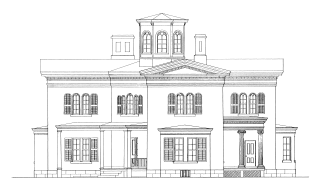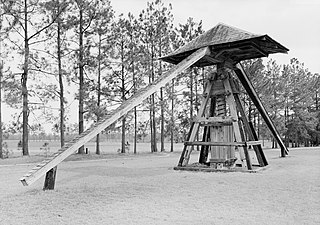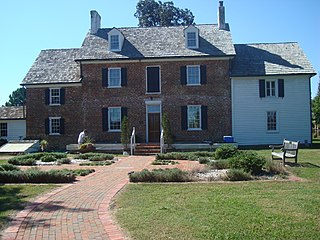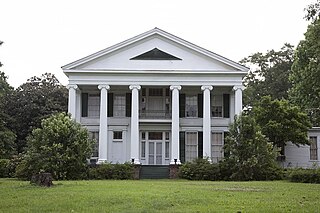
Sherwood Forest Plantation Foundation is located on the north bank of the James River in Charles City County, Virginia. The main plantation house, built in 1730, was the home of the tenth president of the United States, John Tyler (1790–1862) for the last twenty years of his life. It is located on State Route 5, a scenic byway which runs between the independent cities of Richmond and Williamsburg. The house is located approximately 1.5 miles (2.4 km) from the river. It was designated a National Historic Landmark in 1961.

The George Washington Birthplace National Monument is a national monument in Westmoreland County, Virginia, at the confluence of Popes Creek and the Potomac River. It commemorates the birthplace location of George Washington, a Founding Father and the first President of the United States, who was born here on February 22, 1732. Washington lived at the residence until age three and later returned to live there as a teenager.

Cooleemee, also known as the Cooleemee Plantation House, is a house located between Mocksville and Lexington, North Carolina, at the terminus of SR 1812 on the Yadkin River in Davie County, North Carolina. It is a U.S. National Historic Landmark, designated in 1978 for its architecture.

Established in 1994, the Cane River Creole National Historical Park serves to preserve the resources and cultural landscapes of the Cane River region in Natchitoches Parish, Louisiana. Located along the Cane River Lake, the park is approximately 63 acres and includes two French Creole cotton plantations, Oakland and Magnolia. Both plantations are complete in their historic settings, including landscapes, outbuildings, structures, furnishings, and artifacts; and they are the most intact French Creole cotton plantations in the United States. In total, 65 historic structures and over a million artifacts enhance the National Park Service mission as it strives to tell the story of the evolution of plantation agriculture through the perspective of the land owners, enslaved workers, overseers, skilled workers, and tenant farmers who resided along the Cane River for over two hundred years. This park is included as a site on the Louisiana African American Heritage Trail.

West Ashley, or more formally, west of the Ashley, is one of the six distinct areas of the city proper of Charleston, South Carolina. As of July 2022, its estimated population was 83,996. Its name is derived from the fact that the land is west of the Ashley River.

Stenton, also known as the James Logan Home, was the country home of James Logan, the first Mayor of Philadelphia and Chief Justice of the Pennsylvania Supreme Court during the colonial-era governance of the Province of Pennsylvania. The home is located at 4601 North 18th Street in the Logan neighborhood of North Philadelphia.

Magnolia Plantation is a former cotton plantation in Natchitoches Parish, Louisiana. The site was declared a National Historic Landmark in 2001, significant as one of the most intact 19th-century plantation complexes in the nation, as it is complete with a suite of slave cabins and numerous outbuildings and period technology. Included in the Cane River Creole National Historical Park, Magnolia Plantation is also a destination on the Louisiana African American Heritage Trail. It is one of two plantations in the park; the other is Oakland Plantation.

Hampton Plantation, also known as Hampton Plantation House and Hampton Plantation State Historic Site, is a historic plantation, now a state historic site, north of McClellanville, South Carolina. The plantation was established in 1735, and its main house exhibits one of the earliest known examples in the United States of a temple front in domestic architecture. It is also one of the state's finest examples of a wood frame Georgian plantation house. It was declared a National Historic Landmark in 1970.

The Gov. William Aiken House was built in 1820 at 48 Elizabeth Street, in the Wraggborough neighborhood of Charleston, South Carolina. Despite being known for its association with Gov. William Aiken, the house was built by John Robinson after he bought several lots in Mazyck-Wraggborough in 1817. His house was originally configured as a Charleston double house with entrance to the house from the south side along Judith Street. The house is considered to be the best preserved complex of antebellum domestic structures in Charleston. It was the home of William Aiken, Jr., a governor of South Carolina, and before that the home of his father, the owner of South Carolina Canal and Railroad Company, William Aiken.

Hickory Hill, also known sometimes as the Thomas E. Watson House, is a historic house museum at 502 Hickory Hill Drive in Thomson, Georgia. A National Historic Landmark, it was a home of Georgia Populist Party co-founder Thomas E. Watson (1856-1922). The main house was added to the National Register of Historic Places (NRHP) in 1976 (#76002144) and the whole site was added to the NRHP in 1979 (#79003110).

The Tait–Ervin House, also known as Countryside, is a historic plantation house near Camden, Alabama. The two-story wood-frame house was built in 1855 for Robert Tait by a builder named Henry Cook. Robert was the grandson of Charles Tait, a United States Senator from Georgia. The plantation was acquired after the American Civil War by Robert Tait's sister, Sarah Asbury Tait Ervin, and her husband, Dr. Robert Hugh Ervin. Dr. Ervin served in both houses of the Alabama Legislature and was elected President Pro Tem of the state senate in 1872. The house remained in the Ervin family until 1991, when it was sold to the Phillipi family. The house was added to the National Register of Historic Places on February 24, 1995.

The Edwin Reese House, also known as the Reese-Phillips House, is a historic Greek Revival style house in Eutaw, Alabama, United States. The house is a two-story wood-frame building on a raised brick foundation. Four monumental Ionic columns span the front portico. It was built from 1856 to 1859 by Edwin Reese. The house was recorded by the Historic American Buildings Survey in 1936. It was listed on the Alabama Register of Landmarks and Heritage on October 17, 1980. It was added to the National Register of Historic Places as a part of the Antebellum Homes in Eutaw Thematic Resource on April 2, 1982, due to its architectural significance.

The Asa White House, also known as the White-McGiffert House, is a historic house in Eutaw, Alabama, United States. It was built in 1838 by Asa White, one of Greene County's earliest settlers. Eutaw was established on property owned by Asa White. He conveyed 20 acres (8.1 ha) to the newly established county seat in 1838 for the building of a courthouse, civic buildings, and a commercial district. He then sold residential lots to individuals. His house is a two-story frame building. It was built in the Federal style and later altered with the addition of Greek Revival-influenced details. The house was recorded by the Historic American Buildings Survey in 1936. It was added to the National Register of Historic Places as a part of the Antebellum Homes in Eutaw Thematic Resource on April 2, 1982, due to its architectural significance.

The Catlin Wilson House, also known as the Murphy Dunlap House, is a historic Greek Revival style house in Eutaw, Alabama, United States. The one-story wood-framed building was built in 1844. A pedimented front portico with four Doric columns covers the three central bays of the front facade. The house was recorded by the Historic American Buildings Survey in 1936. It was listed on the Alabama Register of Landmarks and Heritage on November 5, 1976. It was subsequently added to the National Register of Historic Places as a part of the Antebellum Homes in Eutaw Thematic Resource on April 2, 1982, due to its architectural significance.

The Tarboro Cotton Press, which is also called the Norfleet Cotton Press or the Edgecombe County Cotton Press, is a wooden cotton press built in the mid-18th century in Edgecombe County, North Carolina. It was moved to the Tarboro Town Common of Tarboro, North Carolina. It was named to the National Register of Historic Places on February 18, 1971. It is located in the Tarboro Historic District.

The Latta Cotton Press is an early mule-powered, wooden cotton press built around 1798. It was built and operated at Berry's Crossroad on South Carolina Highway 38 south of Latta in Dillon County, South Carolina. It was moved about 2.5 mi (4 km) west around 1950. It was listed on the National Register of Historic Places on November 15, 1972.

The Stone Plantation, also known as the Young Plantation and the Barton Warren Stone House, is a historic Greek Revival-style plantation house and one surviving outbuilding along the Old Selma Road on the outskirts of Montgomery, Alabama. It had been the site of a plantation complex, and prior to the American Civil War it was known for cotton production worked by enslaved people.

Ferry Plantation House, or Old Donation Farm, Ferry Farm, Walke Manor House, is a brick house in the neighborhood of Old Donation Farm in Virginia Beach, Virginia. The site dates back to 1642 when Savill Gaskin started the second ferry service in Hampton Roads to carry passengers on the Lynnhaven River to the nearby county courthouse and to visit plantations along the waterway. A cannon was used to signal the ferry, which had 11 total stops along the river. The first ferry service was started nearby by Adam Thoroughgood.

Magnolia Hall, also known as the McCrary-Otts House, is a historic Greek Revival mansion in Greensboro, Alabama. It is a contributing property to the Greensboro Historic District, listed on the National Register of Historic Places, and was individually listed on the National Register in 2021. It was recorded by the Historic American Buildings Survey in late March 1936.

The Bacon-Fraser House is a historic home in Hinesville, Georgia in Liberty County, Georgia, built in 1839, two years after Hinesville was founded. It is a two-story Plantation Plain style house with weatherboard sides. The house is raised and rests on Savannah brick piers. A rear shed room and ell addition was added in 1979, built on foundations that are believed to have been original to rear rooms that were removed in 1923.






















